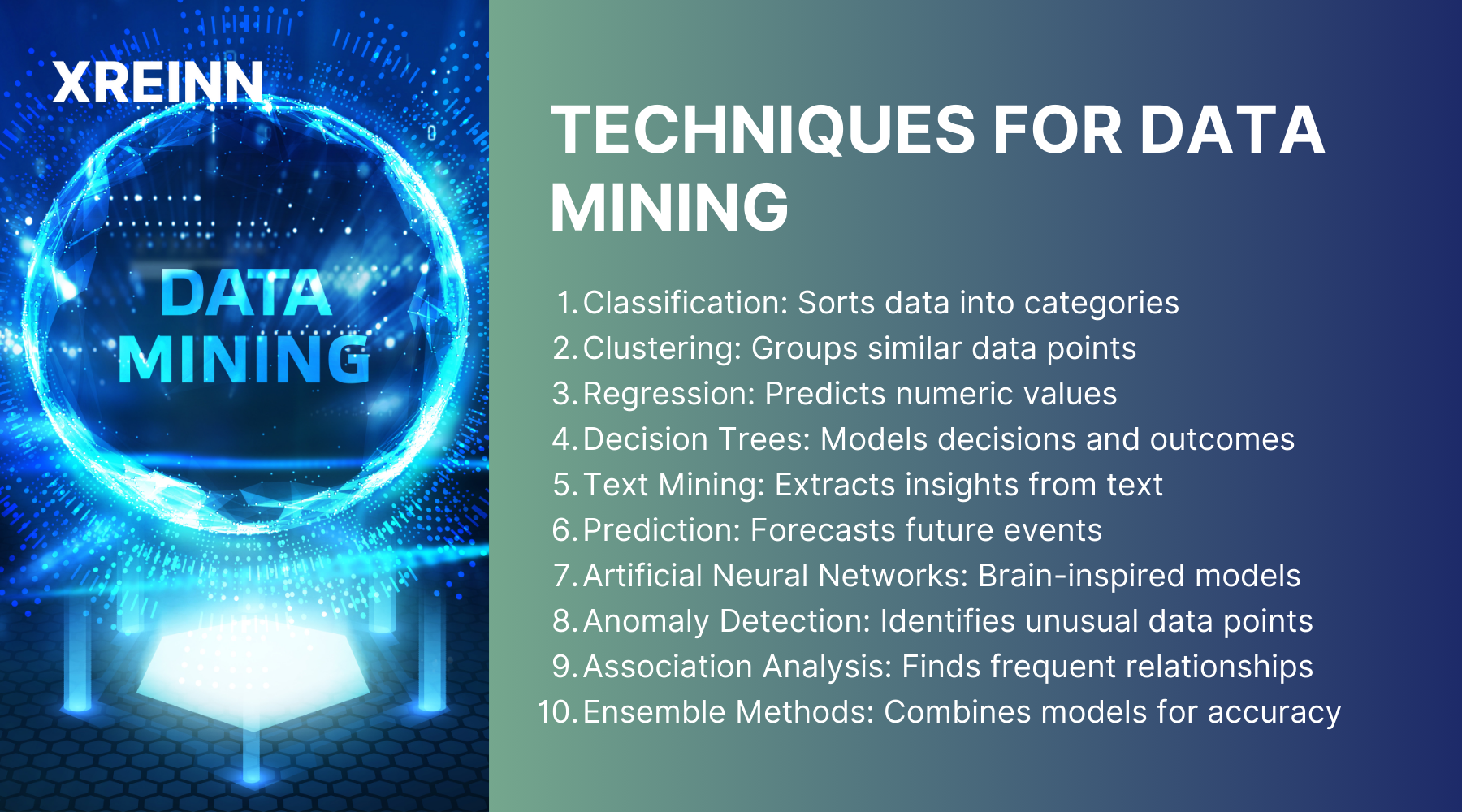Data Analytics
Data Mining: Top 10 Essential Techniques and Tools
Jul 01, 2024
Today, organizations across various industries use data mining to gain insights, make informed decisions, and solve complex business problems. Data mining involves extracting valuable information from large datasets to identify patterns, correlations, and trends. By applying statistical, machine learning, and database management techniques, businesses can predict customer behavior, detect fraud, and improve marketing strategies.
As data continues to grow rapidly, mastering data mining techniques and tools is essential for staying competitive.
In this article, we will highlight the top 10 essential data mining techniques and tools, providing a detailed guide for anyone seeking to effectively utilize data within their organization.
What is Data Mining?
Data mining is defined as the process of filtering, sorting, and classifying data from larger datasets to reveal subtle patterns and relationships. This process helps enterprises identify and solve complex business problems through data analysis. By discovering patterns, correlations, and anomalies within large datasets, data mining allows businesses to predict outcomes and make data-driven decisions.
Data mining aims to predict customer behavior, identify fraud, and improve marketing strategies using various statistical, machine learning, and database management techniques. Due to this, data mining has become a crucial tool across a broad range of industries.
Data Mining Techniques

Data mining encompasses a variety of techniques used in data science and analytics. The choice of technique depends on the problem you're tackling, the data you have, and the outcomes you want to achieve. Predictive modeling, a core component of data mining, is commonly used to make forecasts based on historical data patterns. Often, combining multiple techniques provides a more comprehensive understanding of the data. Here are the top 10 data mining techniques:
1. Classification
Classification is a technique used to sort data into predefined classes or categories based on the features or attributes of the data instances. It involves training a model on labeled data and using it to predict the class labels of new, unseen data instances.
It is widely employed in various applications such as spam detection, credit scoring, and medical diagnosis, where accurate categorization is crucial. Classification models can identify patterns and relationships by analyzing historical data, enabling businesses to make informed decisions and automate complex processes.
2. Clustering
Clustering is a technique that groups similar data points based on their characteristics or similarities. Unlike classification, it doesn’t use predefined categories. Instead, it discovers natural patterns or groupings in the data. This method is useful for tasks like customer segmentation, image processing, and finding unusual data points.
By identifying clusters, businesses can understand the structure of their data and see which data points share similar traits. Popular clustering methods include K-Means, Hierarchical Clustering, and DBSCAN, each suited for different types of data and analysis needs. Clustering simplifies data and helps make further analysis more accurate.
3. Regression
Regression is used to predict numeric or continuous values by examining the relationship between input variables and a target variable. It aims to find a mathematical function or model that best fits the data, enabling accurate predictions.
For example, a regression can help predict a person's salary based on their experience and education level. Common types of regression include linear regression, which fits a straight line to the data, and logistic regression, which is used for binary outcomes. Regression is widely used in finance for forecasting stock prices, in marketing for predicting sales, and in healthcare for estimating patient outcomes.
4. Decision Trees
Decision trees are graphical models that use a tree-like structure to represent decisions and their possible outcomes. They work by repeatedly splitting the data into smaller groups based on different attribute values, forming a hierarchy of decisions. Each node in the tree represents a decision based on an attribute, and each branch represents the outcome of that decision.
For example, in a decision tree for loan approval, the first split might be based on the applicant's credit score. If the score is high, the tree might then consider the applicant's income level. Decision trees are easy to understand and interpret, making them popular for tasks like classification and regression. They are widely used in various fields, such as finance for credit scoring, healthcare for diagnosing diseases, and marketing for customer segmentation.
5. Text Mining
Text mining techniques help extract valuable insights from unstructured text data. These techniques include tasks like categorizing text, analyzing sentiments, modeling topics, and extracting information. By using text mining, organizations can make sense of large volumes of textual data, such as customer reviews, social media posts, emails, and articles. For example, sentiment analysis can determine whether customers feel positively or negatively about a product, while topic modeling can identify common themes in customer feedback. Text mining can also automate the process of sorting through vast amounts of text, saving time and improving decision-making.
6. Prediction
Prediction techniques are used to forecast events, such as machinery failures, faults in industrial components, fraudulent activities, or company profits exceeding a certain level. These techniques analyze trends, establish correlations, and perform pattern matching. By combining prediction with other data mining methods, data miners can analyze past events to predict future outcomes, helping businesses prepare for and minimize potential issues.
7. Artificial Neural Network (ANN) Classifier Method
An artificial neural network (ANN), or neural network (NN), is a computational model inspired by the human brain. It consists of interconnected artificial neurons that adjust their connections based on input data during training. This learning process helps the network predict the correct class labels for new data. Despite long training times and poor interpretability, neural networks excel in handling noisy data and can classify patterns they haven't seen before. They are particularly useful for complex data mining tasks due to their adaptability and accuracy.
8. Anomaly Detection
Anomaly detection, also known as outlier analysis, identifies rare or unusual data instances that deviate significantly from expected patterns. This technique is useful for detecting fraudulent transactions, network intrusions, manufacturing defects, and other abnormal behaviors. By pinpointing these anomalies, businesses can take proactive measures to prevent potential issues. Anomaly detection can be applied in various fields, such as finance, cybersecurity, and quality control, making it a valuable tool for maintaining system integrity and security.
9. Association Analysis
An association analysis is the discovery of attribute-value relationships that occur frequently together in a given dataset. It is widely used for analyzing market baskets or transaction data. The area of association rule mining in data mining research is one of the most important and dynamic. One method of association-based classification, called associative classification, consists of two steps. In the main step, association instructions are generated using a modified version of the standard association rule mining algorithm known as Apriori. The second step constructs a classifier based on the association rules discovered.
10. Ensemble Methods
Ensemble methods combine multiple models to improve prediction accuracy and generalization. Techniques like Random Forests and Gradient Boosting use a combination of weak learners to create a stronger, more accurate model. Other popular methods include Bagging, which reduces variance, and Stacking, which combines different models to leverage their strengths. By integrating multiple models, ensemble methods can achieve better performance than individual models.
Top 10 Data Mining Tools
The top data mining tools are mentioned below:
1. MonkeyLearn
MonkeyLearn is a user-friendly platform for text mining. It helps you extract valuable information from text data, like customer feedback or social media comments. You can use it for tasks like detecting topics, analyzing sentiment, and identifying keywords. It also provides visualizations to make the data easy to understand.
2. Oracle Data Mining
Oracle Data Mining integrates with Oracle's database to offer powerful prediction and personalization capabilities. It helps businesses find valuable customers, detect transaction anomalies, and personalize user experiences. It's a great tool for making data-driven decisions.
3. RapidMiner
RapidMiner is an all-in-one tool for data preparation, machine learning, and predictive analytics. It has an intuitive interface that allows you to create data analysis workflows without extensive coding. It's widely used for both academic research and business applications.
4. IBM SPSS Modeler
IBM SPSS Modeler provides a visual workspace for predictive analytics. It’s designed for large enterprises and offers built-in algorithms and machine-learning capabilities. You can easily create and experiment with models using drag-and-drop interactions.
5. Apache Mahout
Apache Mahout is an open-source framework for large-scale data science. It focuses on collaborative filtering, clustering, and classification. Mahout is designed for high-performance processing and is ideal for big data projects.
6. Dundas BI
Dundas BI is a tool for visual analytics and data integration. It helps you create interactive dashboards and reports that make it easy to track and understand key business metrics. It supports seamless data blending from various sources.
7. Teradata
Teradata is known for its high-performance data warehousing solutions. It handles large-scale data processing and supports complex queries efficiently. Teradata is ideal for businesses that need to manage and analyze vast amounts of data.
8. SAS Data Mining
SAS Data Mining provides advanced analytics and visualization tools. It offers a wide range of algorithms for machine learning and predictive modeling. SAS is trusted by many Fortune 500 companies for its scalability and robust capabilities.
9. KNIME
KNIME is an open-source platform for data analytics. It uses a drag-and-drop interface to create workflows that combine data ingestion, transformation, modeling, and visualization. KNIME is accessible to both technical and non-technical users and integrates well with other analytics tools.
10. Python
Python is a popular programming language for data science due to its simplicity and powerful libraries. Tools like Pandas, NumPy, and Matplotlib make it easy to manipulate data, apply machine learning algorithms, and create visualizations. Python is widely used for developing data analysis prototypes and production systems.
Conclusion
Data mining is essential for organizations to make informed decisions. Techniques like classification, clustering, and regression help uncover insights and predict trends. Tools such as MonkeyLearn, RapidMiner, and Python support these processes.
Mastering these techniques and tools improves your ability to analyze data, identify patterns, and drive initiatives. As data grows, data mining's importance increases.
Use data mining to turn data into actionable insights, improve customer satisfaction, detect fraud, and optimize operations. These methods and tools will help you make decisions that advance your organization.

Data Analytics
Jun 27, 2024Master key concepts in data analytics with practical tips to enhance decision-making and achieve success in your projects and professional growth

Data Analytics
Jul 01, 2024Learn the essential stages of the data analytics workflow to turn your data into valuable business insights and drive growth.

